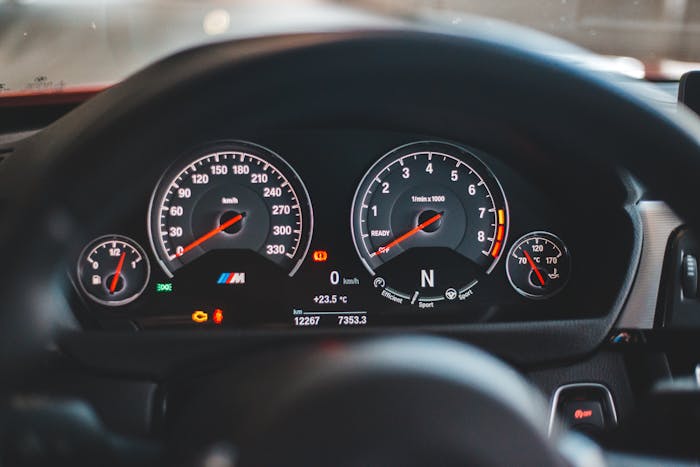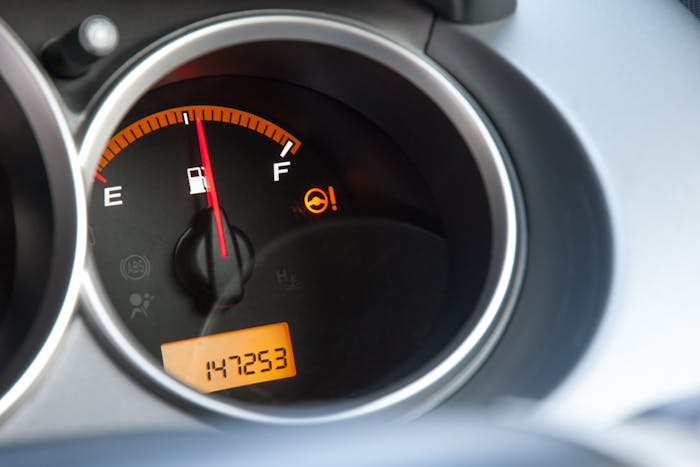Drivers who idle at stoplights and sit in traffic waste both time and fuel. Using eLogii means less time and fuel wasted by delivery drivers waiting at stoplights or stuck in traffic.
"Idling" means that a vehicle's engine is running, but the car isn't going anywhere—like when you're stuck in traffic or waiting for the light to turn green.
Managing a delivery team with eLogii helps reduce idling for better efficiency.
Why is this important?
Nobody enjoys being stuck in traffic, especially your delivery team. They aim to complete their deliveries swiftly and wrap up their day.
As a manager or dispatcher, it's crucial to focus on driver efficiency.
Swift delivery completion reduces the likelihood of delays, keeping customers satisfied.
Fast deliveries = happy customers = beneficial to your business.
(Here's a hint: This is just one method to enhance delivery service).
Idling not only squanders gas but also raises fuel expenses. Trimming down idling time can lead to savings on fuel costs.
Additionally, idling is detrimental to the vehicle's engine, which might shorten its lifespan.
We'll outline the precise amount of fuel lost due to idling and offer guidance on how to assist your driving team in avoiding it.

Idling: A Fuel Consumption Boost

If you're wondering, "does idling affect gas mileage?"—the answer is yes. When a vehicle is idling, it's burning fuel even though it isn't in motion.
This is an unnecessary gas depletion, representing a significant expense for businesses employing delivery drivers.
But just how much gas is wasted idling?

Namely, the South Carolina Department of Health and Environmental Control suggests that idling for only 30 seconds wastes more fuel than restarting the car.
While it's hard to pinpoint an exact figure, idling can lead to significant fuel waste. Some estimates suggest that how much gas a car uses idling for an hour can add up quickly, particularly if this happens regularly.
When a car is idling, the amount of fuel it uses depends on several factors, like it's weight, engine size, fuel type, and overall fuel economy (measured as miles per gallon or MPG).
The exact amount of gas a car uses while idling can vary.
Yet, one thing is clear: Idling is wasteful because the car burns fuel without going anywhere.
This adds to carbon dioxide and greenhouse gas emissions, leading to air pollution.
Additionally, since it squanders fuel, idling also wastes money.
Certain calculations propose that a 1 hour idle car each week could amount to $65 in annual costs for a delivery business per car.
If you have ten drivers on your team, that's a total of $650 each year.
And keep in mind, this estimate is from a time when a gallon of gas was only $2.50 (remember those days?).
Fuel Usage in Idle Vehicles and Non-Diesel Engines
One factor that influences how much gas is used by an idling car is whether it's equipped with a diesel or non-diesel engine.
This distinction is significant to note, particularly because many delivery teams use larger vehicles with diesel engines.
As of June 2022, the average price for regular unleaded gas in the US stood at $5.01.
Thus, 10 hours of idling per week would amount to $8.016 (10 hours x 0.16 gallons/hour = 1.6 gallons → 1.6 gallons x $5.01 = $8.016).
That's $8.016 weekly for just one vehicle.
If you have five vehicles, the weekly cost climbs to $40.08.
In a month? That's $171.77.
And in a year? $2,089.89.
Fuel Usage in Idling Trucks and Diesel Engines
As per the Department of Energy, a diesel truck idling consumes approximately 0.8 gallons per hour.
In April 2024, the average price of one gallon of diesel in the United States was four U.S. dollars.
This marked a decrease compared to the previous month and was also lower than the price recorded in the same month of the previous year.
Yet, 10 hours of idling per week would amount to about $32 (10 hours x 0.8 gallons/hour = 8 gallons).
8 gallons x $4 = $32
Once more, that's per week for just ONE vehicle.
In short, the costs can escalate quickly.
To give you a clearer idea of the impact, "how many gallons of diesel fuel does an idling truck use per hour?"—in this case, approximately 0.8 gallons.
Idling: Potential Harm to the Vehicle's Engine
Keeping the engine running when the vehicle is stationary is detrimental to the engine.
During idling, motor oil deteriorates at a faster rate.
Motor oil plays a crucial role in reducing friction between vital engine components such as cylinders and pistons.
If the motor oil degrades, the likelihood of engine friction rises, leading to wear and tear on these essential engine parts.
Idling can also result in the carbon residue accumulation in the truck's engine, ultimately reducing its lifespan.
Furthermore, idling vehicles also deplete other components, such as the battery, responsible for powering functions like lights, air conditioning, and windshield wipers.
A depleted battery could render the car unable to start, requiring the driver to either jump-start it or call for a tow truck.
For delivery managers, minimizing maintenance cost of idling car is another crucial aspect of reducing overhead expenses.
In 2023, drivers spent an average of 9.83 cents per mile on maintenance, repairs, and tire replacement.
For instance, if a car covers 20,000 miles in a year, the maintenance expenses accumulate to $1,966 annually for one vehicle.
However, it's essential to note that exact maintenance costs can vary based on other factors, such as the type of vehicle.
Idling Leads to Fewer Deliveries
Idling hurts your business by raising overhead expenses such as fuel and vehicle maintenance.
Moreover, it leads to inefficiency among your drivers.
When drivers are stuck idling in traffic or at stoplights, they're not finishing their deliveries as fast as possible.
This could result in late deliveries and, potentially, unhappy customers.

3 Methods to Decrease Idle Time for Your Drivers
1. Create straightforward rules for delivery drivers to decrease idling
For instance, establish a company policy against "warming up the engine."
Another suggestion is to switch off the engine if it's been idling for more than 10 seconds.
Many people believe that turning off and restarting the car is less fuel-efficient than letting it run continuously.
But in reality, this isn't true.
2. Think About Buying Auxiliary Power Units (APUs)
You can further cut idling by purchasing auxiliary power units (APUs). These units power trucks while they're parked, cutting down on fuel usage.
This way, your drivers can still use amenities like the air conditioner without wasting gas.
3. Make Routes Smarter to Dodge Traffic
Improving delivery routes is another way to decrease vehicle idle time.
Route optimization involves finding the quickest sequence for delivery stops.
For instance, effective route optimization groups deliveries in the same area, so drivers don’t need to backtrack.
In the past, managers used traditional tools like maps and Excel sheets for route planning.
Today, route optimization software such as eLogii does the job swiftly.
eLogii utilizes digital maps and real-time traffic data to plan the fastest route sequence for drivers.
It takes into account common obstacles like traffic jams and roadwork that slow down drivers and cause idling.
As a result, drivers operate more efficiently, reducing truck idle times and completing more deliveries.
Delivery route software not only saves time but also cuts down on expenses like fuel.
Therefore, improving idle efficiency can significantly reduce fuel consumption and lower overall operational costs for delivery businesses.
Boost Your Bottom Line with eLogii: Decrease Idle Time
Idling spells trouble.
Does idling waste gas? Yes it does.
It harms the environment.
It harms the engine of the vehicle.
AND it lowers delivery efficiency — causing potential delays and customer dissatisfaction.
Various factors influence the amount of fuel (and money) idling consumes, from the vehicle's size to the type of fuel it runs on.
But one fact remains: Idling is wasteful.
The good news is that we, as delivery managers or dispatchers, can take steps to cut idling.
When it comes to different ways to avoid traffic, delivery drivers can also use route optimization tools, plan deliveries during off-peak hours, and stay updated on real-time traffic information to minimize delays and improve efficiency.
Moreover, we've discussed different options earlier, such as setting guidelines for our driving team to reduce idling, investing in auxiliary power units, and optimizing driver routes to avoid traffic.
Use eLogii to streamline your routes and cut driver idle time. This route planning software efficiently navigates drivers from point A to point B, ensuring they reach their destinations swiftly.
eLogii uses real-time traffic data to help drivers avoid common causes of idling, like heavy traffic and construction zones.
By using eLogii, your drivers can spend more time on the road and cut fuel consumption. This also helps lower your business's costs for fuel and vehicle maintenance.
Maximize Efficiency by Integrating eLogii with Other Tools
%20(1).webp?width=635&height=353&name=elogiisoftware%20(2)%20(1).webp)
To further enhance delivery efficiency, eLogii can also be integrated with complementary software solutions like fleet management systems, GPS trackers, or telematics tools.
This integration provides an all-in-one platform that monitors driver behavior, tracks vehicle locations, and optimizes routes in real time.
Connecting eLogii with such systems creates a more robust framework for managing deliveries, reducing idling, and keeping your operations running smoothly.
For example, with eLogii, Porcelanosa gained a fast, adaptable system that integrates seamlessly with their operations.
They’ve increased speed and flexibility by 10 times compared to their previous system, reduced planning time by over 60%, and streamlined their team.
This has enabled them to generate precise, actionable routes, ensuring their trucks operate at over 90% capacity.
Conclusion
In conclusion, reducing idling is crucial for improving delivery efficiency and lowering operational costs. Idling wastes fuel, harms vehicle engines, and leads to inefficiencies that can cause delays and customer dissatisfaction.
By adopting strategies like optimizing routes, setting clear policies, and investing in auxiliary power units, businesses can cut idle time, reduce fuel consumption, and extend vehicle lifespans. These efforts ultimately contribute to cost savings, smoother operations, and more satisfied customers.
FAQs on Idle Vehicles
